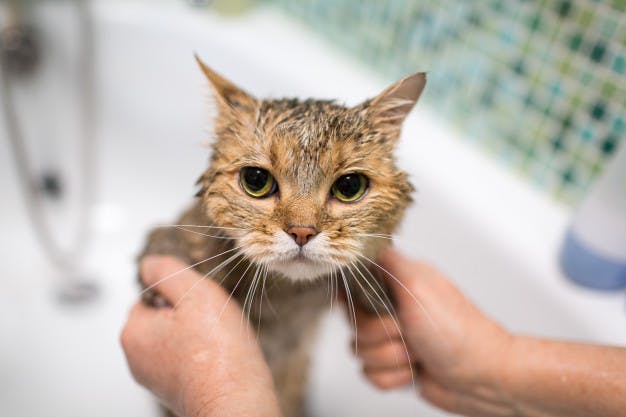We all know that cats are pretty good at handling their own bathing routines by licking their fur. It’s also no secret that they absolutely loathe being wet. But every now and again, it’s necessary to give your kitty a good wash. And when that time comes, you’ll want to be prepared so that bath time is fun for you and your cat.
Why Bathe Your Cat?
Cats are curious, playful, and sometimes rambunctious—the things we love about them the most can sometimes get them into sticky situations. Both indoor and outdoor play can lead to your cat getting into something smelly like garbage, sticky like candy or gum, or hazardous like cleaning products. Not only can these substances be unsafe and uncomfortable for your cat, but you also don’t want anything to be tracked all over your home or rubbed on your couch, carpet, or bedding. In situations like these, your cat should be bathed as soon as possible. Here are some tips to help you make bathing your cat safe and manageable.
How to Safely Bathe Your Cat
Trim your cat’s nails — Once your cat realizes that it’s time for a bath, they will likely become agitated and flail around wildly and you could get scratched. Cat scratches are painful and can become infected easily, so be sure to keep your cat’s claws neatly trimmed.
Brush your cat — Though your cat sheds regularly, you should brush them before bath time, if possible, to get rid of as much loose fur and mats as you can. Not only will less fur help you get a more thorough cleaning, but it will also help prevent hair buildup in your plumbing.
Get traction — Traction in the tub is as important to cats as it is to us. Use a rubber bath mat for your cat to stand on so they don’t panic when it gets slippery. No rubber mat? A folded towel will work too. Now, slowly add 3-4 inches of warm water and take a deep breath.
Use cat shampoo — It’s important to only use a shampoo that was made specifically for cats, not humans. It’s not safe for your cat to lick human shampoo, plus it could also irritate your cat’s sensitive skin. Use the shampoo to massage your cat’s neck and move down to the tail.
Wipe the face — Don’t lather your cat’s face with water and shampoo—just use a damp cloth to wipe down its face. Be careful to avoid getting water in your cat’s eyes and ears. If necessary, put a little bit of shampoo on the damp washcloth and gently wipe their face. Try putting cotton balls in your cat’s ears to keep water out.
Rinse well — Keep a pitcher or a plastic cup of lukewarm water close by so you can rinse your cat thoroughly. Gently pour the water over your cat while being careful to avoid the face. Repeat until all the shampoo is gone. Any remaining shampoo could be ingested by your cat while grooming or become sticky and attract more dirt.
Dry thoroughly — Use a large towel to dry your cat and be sure to keep them warm while they dry. Try using a hair dryer on its lowest setting to speed up the process. If your cat is long haired, use a wide-tooth comb to prevent mats.
5 Tips and Tricks for Easy Cleaning
Here are a few quick tips and tricks to help you better manage bath time:
- Get kittens started early so they can get used to bathing regularly
- Bring in some waterproof toys to keep your kitty distracted and having fun
- Time the bath when your kitty is tired, especially after playing outside, so they’ll be more relaxed
- Get someone to help you hold onto the cat to avoid scratches
- Give your cat a treat after the bath to reward them and create a positive association with bath time
Now you have everything you need to give your kitty a bath time experience that’s fun and relaxing for both of you.
If you have any concerns about any hazardous substances on your cat’s fur, be sure to contact a vet so you can do your best to keep your fur baby safe.





